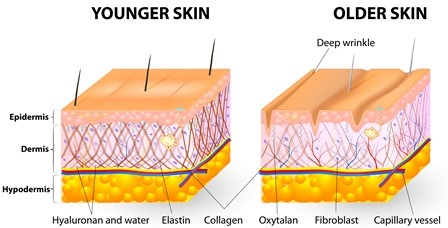Differences Between Collagen and Elastin
Collagen and elastin are two key proteins that play a role in the beauty and health of the skin, giving it firmness, elasticity and resistance. With the passing of time, the production of these proteins will reduce, and, wrinkles will appear due to the loss of elasticity.
These two types of proteins provide together firmness, stiffness and skin elasticity. Collagen keeps the skin in its place, while elastin allows it to return to its original shape every time after it makes a move, thus preventing the apparition of wrinkles.
When we are young, skin does not lack collagen and elastin, so it is firm and wrinkleless. As we get older, the body produces smaller amounts of collagen and elastin, and so the skin gets an aging look. Ultraviolet radiation and pollution contribute to tissue damage and premature aging.

What is Collagen?
Collagen is, in fact, a group of proteins found naturally in our skin, especially in connective, fibrous and supportive tissue. Collagen is the protein that is found in the largest amount in the human body. 30% of the proteins in the human body are of the collagenic kind.
Connective tissues support and connect several types of tissues and organs in the body, being a kind of cellular “glue”. Cartilages, fats and tendons are examples of fibrous tissues. Collagen is also found in ligaments, in blood vessels, in bones and, of course, in the skin.
What is Elastin?
Elastin is a protein produced by fibroblasts that can create a network of elastic fibers (five times more stretchable than a rubber band of the same diameter). These elastin fibers are responsible for the elasticity of the skin.
Elastin fibers account only for 5-10% of the total dermal fiber, but are essential to ensure skin elasticity. Unlike collagen, which is a fibrous protein, elastin is a protein that has the ability to stretch and return to its original form.
Ligaments also contain elastin. In patients with connective tissue or collagen diseases, both collagen and elastin are affected by inflammatory processes.

Differences between Collagen and Elastin
- “Structure” – collagen is a structural protein found in skin and connective tissue, whereas elastin is a structural protein found in the connective tissue of the elastic structures
- “Abundance in the human body” – collagen in the third most abundant protein in the human body, whereas elastin is less abundant
- “Colour” – the colour of collagen is white, whereas the colour of elastin is yellow
- “Function” – collagen gives strength to structures, whereas elastin makes the structures elastic
- “Production” – collagen is produced throughout the life until aging begins whereas elastin is produced during the fetal period.
Collagen vs. Elastin

Summary
- Both collagen and elastin play a decisive role in the overall health of the skin.
- Ultraviolet radiaton can damage collagen and elastin fibers in the human skin, leading in time to skin cancer.
- Collagen is produced in the human body until natural aging occurs, whereas elastin is mainly produced during the fetal period.
- Collagen has the main property of providing structures with strength, whereas elastin will allow the structures which contain it to stretch and return to their initial form without damage.
- Differences Between Collagen and Elastin - May 2, 2018
Search DifferenceBetween.net :
Leave a Response
References :
[0]Image credit: https://upload.wikimedia.org/wikipedia/commons/a/ad/Younger_skin_vs_older_skin.jpg
[1]Image credit: https://pixabay.com/en/fulminan-beautiful-skin-collagen-2336697/
[2]Griffiths, Christopher, et al. “Restoration of Collagen Formation in Photodamaged Human Skin by Tretinoin (Retinoic Acid).” New England Journal of Medicine, no. 8, 1993.
[3]Keeley, F. W., et al. “Elastin as a Self-Organizing Biomaterial: Use of Recombinantly Expressed Human Elastin Polypeptides as a Model for Investigations of Structure and Self-Assembly of Elastin.” Philosophical Transactions of the Royal Society B: Biological Sciences, vol. 357, no. 1418, 2002, pp. 185–189., doi:10.1098/rstb.2001.1027.
[4]Fisher, Gary J., et al. “Pathophysiology of Premature Skin Aging Induced by Ultraviolet Light.” New England Journal of Medicine, vol. 337, no. 20, 1997, pp. 1419–1429., doi:10.1056/nejm199711133372003.
